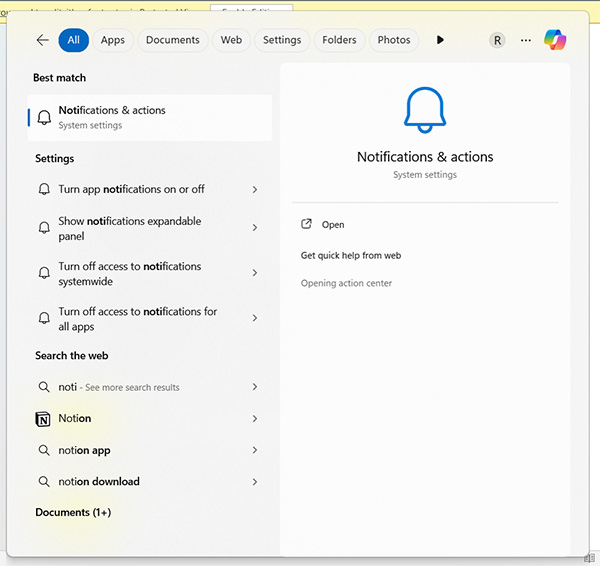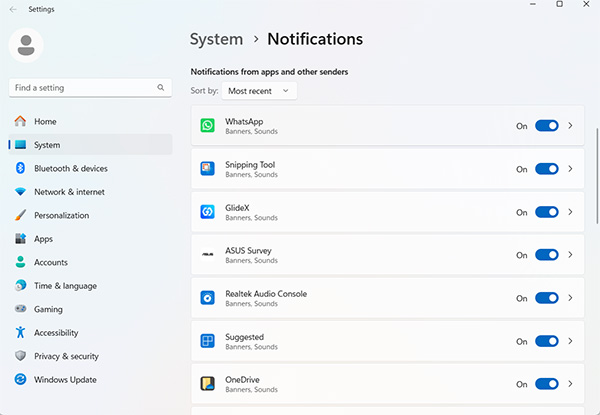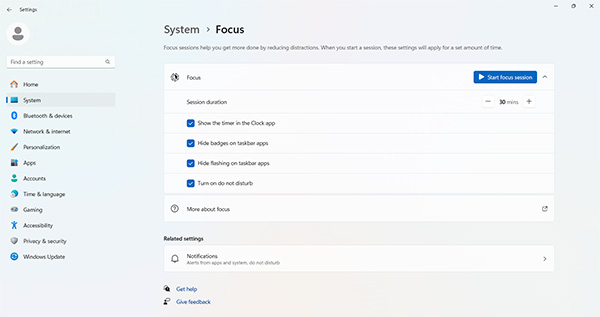Admin
Users & Call Controls
- Creating Extensions for Users
- Editing and Managing Extensions
- Creating Teams & Assigning Extensions
- Configuring Agent Status & BLF
- Managing Extension Schedules
- Managing User Roles
- Managing Call Controls
- Setting up Shared Parking
- Voicemails
- The BLF Function
- Configuring the Speed Dial
- Configuring the Busy Lamp Field (BLF)
Deployment Methods & System Requirements
Installation Guides
RingQ Notifications for Windows 10 and Newer
Introduction
This guide shows you how to enable or disable notifications from your RingQ app on your Windows 10 or newer versions. You can choose to receive notifications for specific actions—or turn them off completely—and also learn how to configure your system’s Focus Assist settings.
Accessing Notification Settings

1. Click the Start button or press the Windows key
2. Select Settings (gear icon)
3. Click on System
4. Select “Notifications & actions” (Windows 10/10 Pro) or “Notifications” (Windows 11)
Enabling Notifications System-Wide
In the Notifications settings page:
1. Toggle “Get notifications from apps and other senders” to ON to enable system-wide notifications
2. Choose which system notifications to receive by toggling options like:
- Show notifications on the lock screen
- Show reminders and incoming VoIP calls on the lock screen
- Show notification banners
Play sounds for notifications
Managing App Notifications
1. Scroll down to the “Get notifications from these senders” section
2. Toggle the switch for each app to On or Off
3. Click on an app name to customize its specific notification settings

App-Specific Settings Include:
- Show notification banners
- Show notifications in action center
- Play a sound when a notification arrives
- Number of notifications visible in action center
- Priority of notifications in action center
Customizing Notification Appearance
Banner Settings
Windows 10/10 Pro:
1. Go to Settings > System > Notifications & actions
2. Under “Show notifications for”, adjust how long notifications appear on screen (default is 5 seconds)
Windows 11:
1. Go to Settings > System > Notifications
2. Click on “Notification timing”
3. Adjust how long notifications appear on screen
Action Center Customization
In Notification settings, you can configure:
1. Choose whether to show notifications in chronological order or grouped by app
2. Set the number of visible notifications per app
Using Focus Assist

Focus Assist (formerly Quiet Hours) helps you control when notifications appear:
1. Go to Settings > System > Focus assist
2. Choose from three modes:
- Off: Show all notifications
- Priority only: Show only notifications from priority apps/contacts
- Alarms only: Hide all notifications except alarms
Automatic Rules
You can set Focus Assist to activate automatically:
1. During specific hours
2. When duplicating your display
3. When playing games
4. When using an app in full-screen mode
Troubleshooting
Check Basic Settings
1. Ensure notifications are enabled system-wide
2. Verify the specific app has notifications enabled
3. Check if Focus Assist is turned on (look for moon icon in taskbar)
App-Specific Issues
1. Open the problematic app’s settings
2. Look for in-app notification settings that might override Windows settings
3. Try reinstalling the app if notifications still don’t work
System-Level Fixes
1. Restart your computer
2. Ensure Windows is up to date:
- Windows 10/10 Pro: Go to Settings > Update & Security > Windows Update
- Windows 11: Go to Settings > Windows Update
3. Run the Windows Troubleshooter:
- Windows 10/10 Pro: Go to Settings > Update & Security > Troubleshoot
- Windows 11: Go to Settings > System > Troubleshoot > Other troubleshooters
Additional Tips
- Quick Focus Assist Toggle: Click the notification icon in the taskbar, then click “Focus assist” to quickly change modes
- Notification Priorities: Set important apps to “Top” priority to always see them first in the Action Center
- Windows 10 Pro Features: Take advantage of Group Policy Editor to manage notifications across multiple devices in a domain environment
- Windows 11 Notification History: Enable notification history to see past notifications (Settings > System > Notifications > Notification history)
Version-Specific Differences
Windows 10 vs Windows 11
- Menu Navigation: Windows 11 has a simplified settings menu where “Notifications” is its own section under System
- Notification Center Design: Windows 11 has a redesigned notification center with separated notifications and quick settings panels
- Notification History: Windows 11 adds a notification history feature to review past notifications
- Focus Modes: Windows 11 expands on Focus assist with additional focus modes
Windows 10 Home vs Windows 10 Pro
- Group Policy: Windows 10 Pro users can configure notification settings via Group Policy Editor for enterprise environments
- Domain Management: Pro version allows centralized notification management in domain-joined environments
